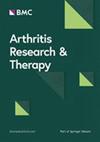糖酵解- hif -1α轴诱导类风湿关节炎巨噬细胞IL-1β
IF 4.6
2区 医学
Q1 Medicine
引用次数: 0
摘要
类风湿关节炎(RA)是一种侵袭性的系统性自身免疫性疾病,过度激活的巨噬细胞在其发病机制中起关键作用。本研究旨在探讨糖酵解重编程在RA巨噬细胞产生促炎细胞因子中的潜在作用。海马实验在RA或健康对照(HC)血清处理的人单核细胞来源的巨噬细胞(HMDMs)上进行,以评估糖酵解水平。通过RNA测序鉴定RA血清刺激HMDMs的激活信号通路和关键分子。Western blotting和qPCR检测促炎因子和缺氧诱导因子1α (HIF-1α)的表达。我们发现,与HC血清相比,RA血清刺激的HMDMs表现出更高的有氧糖酵解水平,同时糖酵解相关基因的表达也更高,包括己糖激酶2 (HK2)、丙酮酸激酶L/R (pkr)和磷酸甘油酸激酶1 (PGK1)。此外,RA血清处理的巨噬细胞表现出更高水平的白细胞介素-1β (IL-1β), IL-1β的表达与HK2呈正相关。3-溴丙酮酸(3BrPA)抑制糖酵解或敲低HK2可显著抑制巨噬细胞中IL-1β的产生。在RA血清处理的巨噬细胞中,HIF-1α-相关信号通路和HIF-1α蛋白水平也升高。3BrPA抑制糖酵解或敲低HK2可降低HIF-1α。抑制HIF-1α可抑制RA血清处理的巨噬细胞产生IL-1β,反之亦然。TNF-α和IL-1β增强巨噬细胞中HIF-1α和IL-1β的表达,糖酵解抑制可减弱这一作用。阻断RA血清中TNF-α和IL-1β可降低糖酵解和IL-1β的产生。我们的研究结果表明,RA血清触发巨噬细胞的有氧糖酵解,从而促进HIF-1α驱动IL-1β的产生。值得注意的是,RA血清中的IL-1β通过糖酵解- hif -1α轴扩增自身表达,在RA中建立致病正反馈回路。本文章由计算机程序翻译,如有差异,请以英文原文为准。
The Glycolysis-HIF-1α axis induces IL-1β of macrophages in rheumatoid arthritis
Rheumatoid arthritis (RA) is an aggressive, systemic autoimmune disease in which overactivated macrophages play a critical role in its pathogenesis. This study aimed to explore the potential role of glycolytic reprogramming in the production of proinflammatory cytokines by macrophages in RA. The Seahorse assay was conducted on RA or healthy control (HC) serum-treated human monocyte-derived macrophages (HMDMs) to evaluate glycolysis levels. RNA sequencing was performed to identify activated signaling pathways and key molecules in HMDMs stimulated by RA serum. The proinflammatory cytokines and hypoxia-inducible factor 1α (HIF-1α) were verified by Western blotting and quantitative polymerase chain reaction (qPCR). We found that HMDMs stimulated with RA serum showed higher aerobic glycolysis levels than those treated with HC serum, along with higher expression of glycolysis-related genes, including hexokinase2 (HK2), pyruvate kinase L/R (PKLR), and phosphoglycerate kinase 1 (PGK1). Furthermore, RA serum-treated macrophages exhibited a higher level of interleukin-1 beta (IL-1β), and the expression of IL-1β positively correlated with HK2. Inhibition of glycolysis by 3-bromopyruvate (3BrPA) or HK2 knockdown significantly suppressed IL-1β production in macrophages. The HIF-1α-associated signaling pathways and HIF-1α protein levels were also elevated in RA serum-treated macrophages. Inhibition of glycolysis by 3BrPA or knockdown of HK2 reduced HIF-1α. Inhibiting HIF-1α can suppress IL-1β production of RA serum-treated macrophages, and vice versa. TNF-α and IL-1β enhanced HIF-1α and IL-1β expression in macrophages, an effect attenuated by glycolysis inhibition. Blocking TNF-α and IL-1β in RA serum diminished both glycolysis and IL-1β production. Our findings demonstrate that RA serum triggers aerobic glycolysis in macrophages, which promotes HIF-1α to drive IL-1β production. Notably, IL-1β within RA serum amplifies its own expression via this glycolysis-HIF-1α axis, establishing a pathogenic positive feedback loop in RA.
求助全文
通过发布文献求助,成功后即可免费获取论文全文。
去求助
来源期刊

Arthritis Research & Therapy
RHEUMATOLOGY-
CiteScore
8.60
自引率
2.00%
发文量
261
审稿时长
14 weeks
期刊介绍:
Established in 1999, Arthritis Research and Therapy is an international, open access, peer-reviewed journal, publishing original articles in the area of musculoskeletal research and therapy as well as, reviews, commentaries and reports. A major focus of the journal is on the immunologic processes leading to inflammation, damage and repair as they relate to autoimmune rheumatic and musculoskeletal conditions, and which inform the translation of this knowledge into advances in clinical care. Original basic, translational and clinical research is considered for publication along with results of early and late phase therapeutic trials, especially as they pertain to the underpinning science that informs clinical observations in interventional studies.
 求助内容:
求助内容: 应助结果提醒方式:
应助结果提醒方式:


